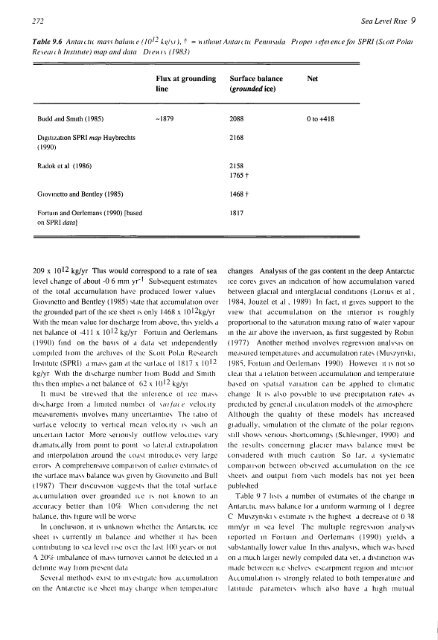First Assessment Report - IPCC
First Assessment Report - IPCC
First Assessment Report - IPCC
Create successful ePaper yourself
Turn your PDF publications into a flip-book with our unique Google optimized e-Paper software.
272 Sea Level Rise 9<br />
Table 9.6 Antaictic mass balance (10'- kt>/\i), f = without Antaictic Peninsula Piopei iefeiencefoi SPRI (Scott Polai<br />
Reseai c h Institute) map and data Di ev, i \ (1983)<br />
Flux at grounding Surface balance Net<br />
line<br />
(grounded ice)<br />
Budd and Smith (1985) -1879 2088 0 to+418<br />
Digitization SPRI map Huybrechts 2168<br />
(1990)<br />
Radoketal (1986) 2158<br />
1765 t<br />
Giovinetto and Bentley (1985)<br />
1468 t<br />
Fortuin and Oerlemans (1990) [based 1817<br />
on SPRI data]<br />
209 x 1012 kg/yr This would correspond to a rate of sea<br />
level change of about -0 6 mm yr' Subsequent estimates<br />
ot the total accumulation have produced lower values<br />
Giovinetto and Bentley (1985) state that accumulation over<br />
the grounded part of the ice sheet is only 1468 x l()'2kg/yr<br />
With the mean value lor discharge from above, this yields a<br />
net balance ol -411 x 10'2 kg/yr Fortuin and Oerlemans<br />
(1990) find on the basis ot a data set independently<br />
compiled tiom the archives ol the Scott Polai Research<br />
Institute (SPRI) a mass gain at the suilace ol 1817 x 10 12<br />
kg/yr With the discharge number horn Budd and Smith<br />
this then implies a net balance of 62 x 10'2 kg/yi<br />
It must be stressed that the infeience of ice mass<br />
discharge from a limited numbci ol suiface velocity<br />
measurements involves many uncertainties The latio of<br />
surface velocity to vertical mean velocity is such an<br />
unceitain lactor More senously outflow velocities vary<br />
diamatically from point to point so lateial extrapolation<br />
and interpolation around the coast mtioduces very large<br />
eirors A comprehensive companson ot eailiei estimates of<br />
the surface mass balance was given by Giovinetto and Bull<br />
(1987) Their discussion suggests that the total surface<br />
accumulation over grounded ice is not known to an<br />
accuracy better than 10% When considering the net<br />
balance, this figure will be worse<br />
In conclusion, it is unknown whethci the Antarctic ice<br />
sheet is currently in balance and whether it has been<br />
contnbuting to sea level use o\ei the last 100 years oi not<br />
\ 209r imbalance ol mass turnovei cannot be detected in a<br />
definite way tiom piesent data<br />
Seveial methods exist to investigate how accumulation<br />
on the Antaictic ice sheet may change when tempciatuie<br />
changes Analysis of the gas content in the deep Antarctic<br />
ice cores gives an indication of how accumulation varied<br />
between glacial and interglacial conditions (Lonus et al,<br />
1984, Jouzel et al , 1989) In fact, it gives support to the<br />
view that accumulation on the interior is roughly<br />
proportional to the saturation mixing ratio of water vapour<br />
in the air above the inversion, as first suggested by Robin<br />
(1977) Another method involves regression analysis on<br />
measuied tcmpeiatuies and accumulation rates (Muszynski,<br />
1985, Foituin and Oeilemans 1990) Howevei it is not so<br />
cleai that a lelation between accumulation and temperatuie<br />
based on spatial vanation can be applied to climatic<br />
change It is also possible to use piecipitation rates as<br />
predicted by gencial cuculation models of the atmosphere<br />
Although the quality of these models has increased<br />
giadually, simulation ot the climate of the polar regions<br />
still shows serious shortcomings (Schlesinger, 1990) and<br />
the lesults concerning glacier mass balance must be<br />
considered with much caution So far, a systematic<br />
companson between obseived accumulation on the ice<br />
sheets and output fiom such models has not yet been<br />
published<br />
Table 9 7 lists a numbci ol estimates ot the change in<br />
Antarctic mass balance lor a uniform warming of 1 degree<br />
C Muszynski s estimate is the highest a decrease of 0 38<br />
mm/yr in sea level The multiple regression analysis<br />
icported in Foituin and Oerlemans (1990) yields a<br />
substantially lower value In this analysis, which was based<br />
on a much laigei newly compiled data set, a distinction was<br />
made between ice shelves escarpment region and mtenor<br />
Accumulation is strongly related to both tempeiatuie and<br />
latitude paramcteis which also have a high mutual
















